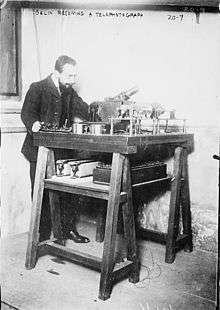Wirephoto
 Belinograph BEP2V wirephoto machine by Edouard Bélin, 1930 | |
| Process type |
Physical Analogue |
|---|---|
| Industrial sector(s) |
Wire Service Photojournalism |
| Main technologies or sub-processes |
Telegraph Telephone Photography |
| Product(s) | Telefaxed photographs |
| Leading companies |
Western Union AT&T Associated Press etc. |
| Year of invention | 1920s |
Wirephoto,telephotography or radiophoto is the sending of pictures by telegraph, telephone or radio.
Western Union transmitted its first halftone photograph in 1921. AT&T followed in 1924,[1] and RCA sent a Radiophoto in 1926. The Associated Press began its Wirephoto service in 1935 and held a trademark on the term AP Wirephoto between 1963 and 2004. The first AP photo sent by wire depicted the crash of a small plane in New York's Adirondack Mountains.[2]
Technologically and commercially, the wirephoto was the successor to Ernest A. Hummel's Telediagraph of 1895, which had transmitted electrically scanned shellac-on-foil originals over a dedicated circuit connecting the New York Herald and the Chicago Times Herald, the St. Louis Republic, the Boston Herald, and the Philadelphia Inquirer.[3][4]

Édouard Belin's Belinograph of 1913, which scanned using a photocell and transmitted over ordinary phone lines, formed the basis for the AT&T Wirephoto service. In Europe, services similar to a wirephoto were called a Belino.
The first wirephoto systems were slow and did not reproduce well. In 1929, Dr. Vladimir Zworykin, an electronics engineer working for Western Electric, came up with a system that produced a better reproduction and could transmit a full page in approximately one minute.[5]
In the 1930s, wirephoto machines of any reasonable speed were very large and expensive and required a dedicated phone line. News media firms like Associated Press used expensive leased telephone lines to transmit wirephotos. In the mid-1930s a technology battle began for less expensive portable wirephoto equipment that could transmit photos over standard phone lines. A prototype device in the experimental stage was available in San Francisco in 1935 when the large Navy airship Macon crashed into the Pacific off the coast of California. A photo was taken and transmitted to New York over regular phone lines. Later, a wirephoto copier and transmitter that could be carried anywhere and needed only a standard long-distance phone line was put into use by International News Photos.[6]
During the US leaflet dropping campaign aimed towards the then Empire of Japan, near the end of WWII. Honolulu would transmit some radiophoto images to Saipan depicting proposed leaflet messages for the printing press on Saipan to produce.[7]
See also
| Wikimedia Commons has media related to Telephotography. |
Footnotes
- ↑ "1924: Fax Service". AT&T Labs timeline. Retrieved 2010-06-30.
- ↑ "AP History 1901-1950: The Modern Cooperative Grows". Associated Press. Retrieved 2010-06-30.
- ↑ Cook, Charles Emerson (April 1900). "Pictures by Telegraph (HTML transcription)". Pearson's Magazine. Retrieved 2010-06-30.
- ↑ "From Pearson's Magazine, April 1900 Pictures by Telegraph". Retrieved 2010-06-30.
- ↑ "Photo Letters Sent in a Minute by Radio". Popular Science. September 1929. p. 62. Retrieved 2012-04-28.
- ↑ Schnurmacher, Emile C (July 1937). "Wire That Photo". Popular Mechanics. pp. 392–395, 128A–133A. Retrieved 2012-04-28.
- ↑ The Information War in the Pacific, 1945 Paths to Peace, Josette H. Williams.
Further reading
- "Pictorial Telegraphy," Literary Digest, vol. 10, no. 19 (March 9, 1895), pg. 14.